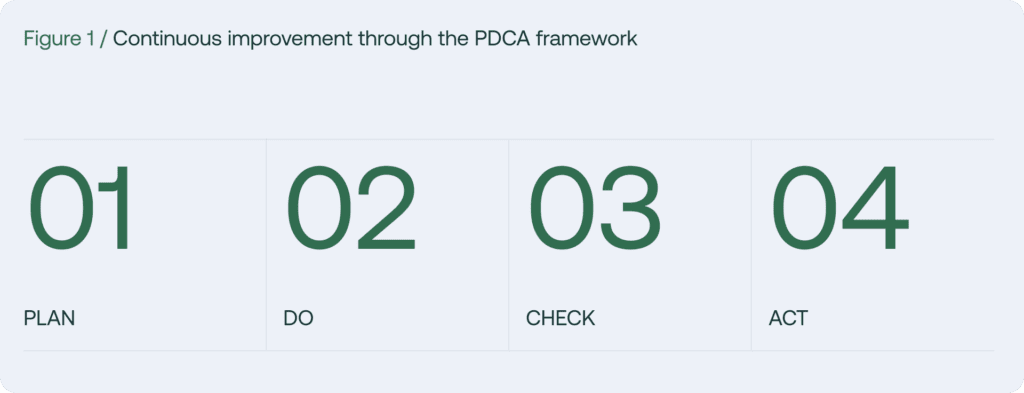 Why should you develop an SBTi-validated emissions reduction target?
Why should you develop an SBTi-validated emissions reduction target?
The European Union’s Corporate Social Responsibility Directive (CSRD) requires organisations to report on their sustainability strategy and performance.
Regardless of whether your organisation falls within the CSRD scope or not, this cornerstone piece of legislation will likely affect your activities.
The prerequisite for organisations in the EU to collect value chain data is extensive. As reporting is required annually, the CSRD aims to effectively nudge progress in sustainability performance.
This, in turn, will likely increase EU (business-) clients’ interest in more sustainable partners and suppliers.
Therefore, we foresee that the CSRD will have a worldwide ripple effect that will increase stakeholders’ interest in ESG performance information.
This guide aims to help organisations anticipate this demand by outlining the steps for monitoring and evaluating ESG performance.
Breaking down the CSRD requirements
Under the CSRD, the European Commission released twelve (draft) European Sustainability Reporting Standards (ESRS) that detail the reporting requirements and provide guidance.
The CSRD requires organisations to disclose the policies, targets, and metrics regarding each material topic.
Fundamental to sustainability reporting will be the double materiality assessment to define an organisation’s material topics.
Read part one of this article, “Reporting on Impacts, Risks & Opportunities“, to learn more about the double materiality assessment required under the CSRD.
In this context, metrics are the qualitative and quantitative indicators that organisations use to measure and report on progress over time.
The purpose of such reporting is “to enable users to understand how an entity measures and monitors its significant sustainability-related financial risks and opportunities” (ESRS 5, 2022).
The Metrics and Targets section of the relevant [draft] topical ESRS is guiding and will generally declare the following recurring aspects:
- Disclose implemented policies;
- Disclose any outcome-oriented targets;
- Describe the process for setting the targets;
- Explain the internal roles and responsibilities.
Continuous improvement through the PDCA Framework
Essentially, the CSRD urges organisations to structure their efforts by adopting a formal sustainability strategy. To guarantee the success of your organisation’s sustainability strategy, a structured Sustainability Management System is crucial.
A Sustainability Management System is the collection of policies, processes, and procedures set in place to achieve goals and continuous improvement.
The “Plan-Do-Check-Act” framework is useful when structuring processes in a way that allows for continuous improvement. Essentially, this framework lays down 4 essential steps to structuring and advancing sustainability ambitions:
Plan
Identify important topics, and establish sustainability objectives and processes necessary to deliver results in accordance with the organisation’s mission and policies.
Do
Implement the processes as planned.
Check
Monitor and measure processes against commitments, including environmental objectives and operating criteria, and report on the results.
Act
Take actions to improve, such as corrective actions, improvement of current processes and review of non-conformities.

How to set sustainability goals
The following steps guide you in setting sustainability goals and in monitoring your sustainability performance:
Step 1
Identify key sustainability issues. A double materiality assessment is best practice and required by the CSRD to identify material topics based on your organisation’s risks and opportunities.
Make sure to define a timeline for updating your double materiality assessment (this varies from every year to every three years).
Step 2
Develop sustainability goals that are Specific, Measurable, Achievable, Relevant, and Time-bound (SMART).
Make sure to involve stakeholders in the goal-setting process to ensure relevant input is at the core of these goals. Stakeholder expectations, available (baseline) data, and action planning are key ingredients to setting well-informed and data-based goals.
Nexio Projects has developed a goalsetting template which can be accessed here.
Step 3
Define roles and responsibilities for the relevant internal stakeholders. Each sustainability goal should have an internal ultimate Accountable owner.
The Accountable owner:
- Oversees the progress on the goals;
- Decides on the actions that ought to be taken to make valuable improvements;
- Ensures KPIs are monitored and evaluated annually. The highest governance body of your organisation must have an explicit role in reviewing the sustainability strategy and reporting.
Step 4
Establish the KPIs or Key Performance Indicators, the core metrics with which you determine progress made towards your goals.
KPIs will allow for continuous progress monitoring. For each goal, you want to ask yourself:
“How can progress towards this goal be measured?”
For the CSRD, it is important to ensure that all CSRD-required metrics are also defined and integrated into the set of KPIs used to monitor progress.
Step 5
The next step is to establish the data collection processes and define the tools used to collect and store data. When looking at the data collection processes, you need to:
- Define who needs to collect what type of data, in what format, and how frequently;
- Decide what tools will be used to share the data (for example an MS Excel file), and where the data will be finally stored and processed. Examples of such tools are Position Green and Sweep;
- Inform stakeholders who will provide the data, to give guidance about the processes, tools and anything else they need to know.
Step 6
Evaluate the collected KPI data at least annually. Monitoring and evaluating sustainability KPIs allow you to determine promptly whether your organisation is well on track to achieving its objectives.
Search for any opportunities for innovation and improvement, and be on the lookout for any (unexpected) challenges. Both improvement opportunities and challenges should be addressed by adopting (additional) corrective actions.
Step 7
Have your KPI data assured by a thereto accredited third-party auditor.
The CSRD requires at least limited assurance of sustainability data. Here, the primary focus is on the reduction of material misstatement of inquiry, observation, and analytical procedures with attention to substantive testing of metrics and their sources.
It identifies reporting of incorrect or inaccurate information, which can impact the economic decisions of stakeholders relying on the stated information.
Step 8
Review and update your sustainability strategy regularly.
Based on the evaluation of the KPI data and the regularly updated double materiality assessment, an update of the SMART sustainability goals may be called for. Make sure that assessing the necessity of updating the sustainability goals is a standard conversation when evaluating your sustainability performance.
Step 9
Inform stakeholders about sustainability reporting. Based on the outcomes of the above annual process, your organisation should be able to reflect substantially on its performance and disclose such findings in a sustainability report.
A sustainability report aims to inform internal and external stakeholders in line with CSRD and ESRS requirements.
Conclusion
When reporting on your organisation’s sustainability performance you should adhere to the following:
- Sustainability reporting should be consistent with your organisation’s financial statements;
- Organisations should link past, current, and future information to clarify how past performance relates to and motivates future action plans;
- The sustainability report should compare one year of comparative information in respect of all metrics disclosed in the current period with base year information to establish the development and progress on goals;
- In case of errors in previous sustainability report(s) (e.g. due to mathematical mistakes), organisations should disclose restatements of comparative amounts related to such errors.
To comply with the CSRD, organisations are urged to define their sustainability strategy and structure their Sustainability Management System well before they hit their deadline for external reporting. Such best practice management structures significantly support organisations in improving their sustainability performance and reporting externally to satisfy stakeholders.











